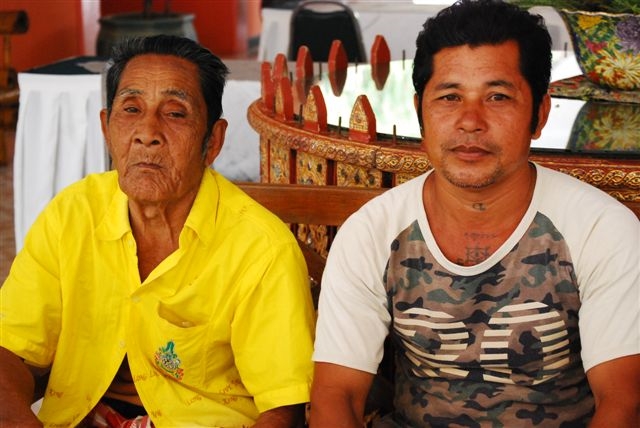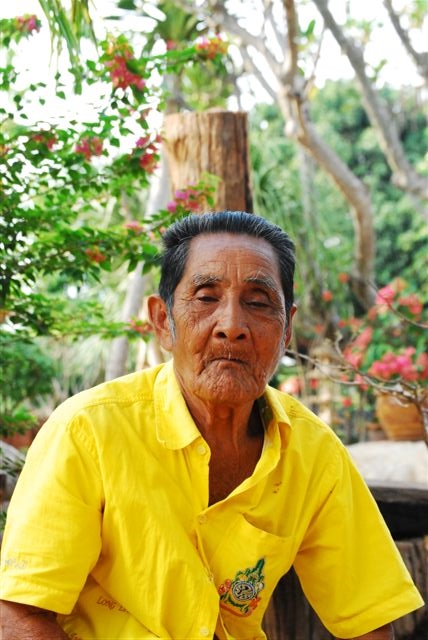 |
 |
![]()
| ROMUSHA |
| Thong Yu |
On 28 February 2008, when in the vicinity of Pung Waan Resort Kwai Noi, I had the privilege of interviewing Thong Yu (in Thai means Long Life). The interview was facilitated by Khun Vivatchai Wongsuvat (Travel Agent of Bangkok who arranges the Defence Reserves Association trips to Thailand for Remembrance Day each year). Thong Yu's second son (48 Years) also assisted.
 |
Thong Yu had been forced to labour for the Japanese on the Burma Thailand Railway over the period 1942 to 1945. This labour force was generally referred to as "Romusha". Thong Yu's Malay name was Salhae and his family lived in the vicinity of Kota Bahru in the North East of Malaya. In fact, Kota Bahru was the location where the Japanese invasion force landed on 7/8 December 1941. His family were Moslems.
According to Thong Yu, in 1942 the Japanese approached Malay families offering to take able sons to do contract work. They allowed one son to remain with the family and, in the case of Thong Yu's family that was the eldest son. A payment of Thai Baht 600 was made to Thong Yu's parents.
As a 16 year old he was sent to Thailand and subsequently became a slave labourer on the Burma Thailand Railway. He and a number of other young males from his area were moved to Thailand by train in open cattle trucks. Their destination in Thailand was Non Pladuk, which was the point where the railway to Burma branched off the main line connecting Bangkok and Singapore.
Whilst forced to work on the railway he had to break stone for ballast, lay sleepers and also lay the steel rail lines themselves. It is assumed that this was mainly in the area between Non Pladuk and Kanburi (now known as Kanchanaburi). However Thong Yu assured me that he worked between Non Pladuk and Konyu Cutting (Hellfire Pass).
He says that treatment by the Japanese was reasonable, but, treatment by the Korean guards was bad. Many were forced to work even when sick. Many died from Malaria and he was aware of large numbers who died from Cholera. They had 3 meals a day and the ingredients were rice with salted fish or meat. The Romusha lived in tents and were constantly under guard. He does not remember any women or children being with them nor does he remember any British or Australian doctors or medical orderlies being with them.
 |
After labouring for about 2 years, when in the vicinity of Konyu, he and about 50 others escaped. They jumped into the river and used bamboo as floatation devices. When they escaped, the Japanese or Korean guards machine gunned them in the water.
He floated down the river for some days, finally stopping at Ban Kao (Thai meaning said to be "White Crocodile"). Here he was cared for by some monks until the war ended. He remembers the allied bombing raids on the Tamarkan Bridge and the Wampo bridging (Viaduct). He also remembered the image and sound of the first train (steam) which he saw on the line. He actually portrayed the "Clickety-clack" sound of the train passing over the rail joints.
After the war he became a Mahout. With his elephant he hauled logs out of the jungle. He married a lady whose family lived at Ban Kao. They had 6 children the eldest of whom is 51 years. His wife died around 2002 and in 2008 he resides near Namtok.
He is visited each January by a former Japanese officer, who may be Nagase Takashi. On one occasion his Japanese visitor took him to his home town on Malaya - Kota Bahru. However, he did not recognise the place nor did he know anyone there.
Thong Yu is now over 80 years and it was a pleasure to interview this dignified gentleman.
Lt Col Peter Winstanley OAM RFD JP conducted the interview with Khun Vivatchai Wongsuvat interpreting.
email peterwinstanley@bigpond.com
website www.pows-of-japan.net
|
|